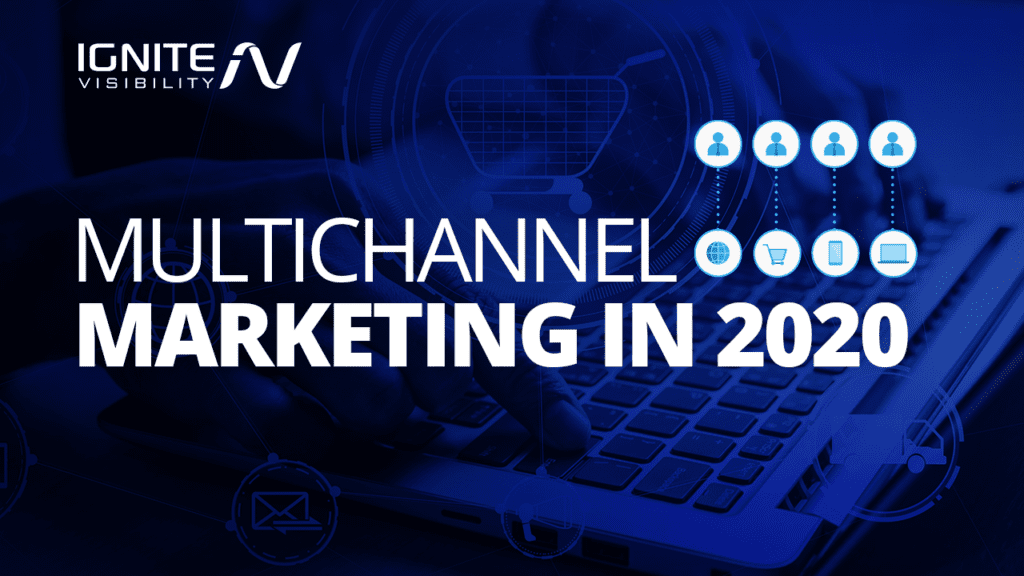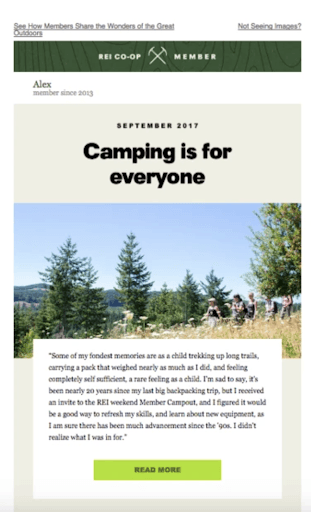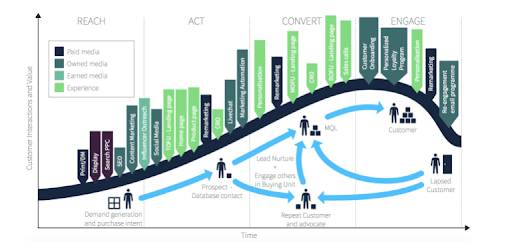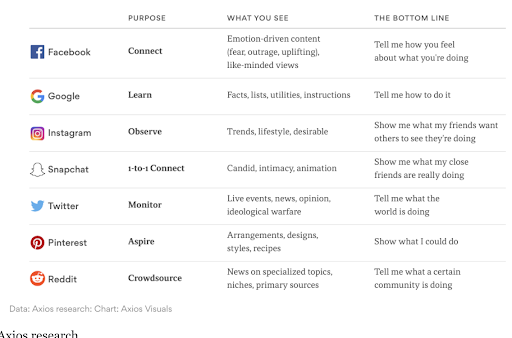Multichannel marketing is a broad term that describes the process of interacting with customers using a mix of direct and indirect communications channels.
Dig a few years back in Google’s digital marketing archives and you’ll see that circa 2014, 2015 multichannel marketing was all the rage. However, since then, the practice has given way to the customer-centric omnichannel strategy.
But what is multichannel marketing, and is it still an effective strategy in 2020 and beyond?
In this article, I’m going to talk about multichannel marketing; I’ll cover its benefits, challenges, and why simply being on as many channels as possible isn’t enough to be successful in today’s complex digital marketing landscape.

What You’ll Learn:
- What is multichannel marketing
- Bringing together online and offline channels
- The differences between multichannel and omnichannel
- Benefits of multichannel marketing
- How to create a successful multichannel strategy
What is Multichannel Marketing?
Okay, before we get too deep into it, here’s a quick multichannel marketing definition:
Multichannel marketing is a strategy that involves promoting and selling your products or services anywhere customers might make a purchase. This includes advertising of all types, social media platforms, messaging apps, TV spots, your website, and physical stores.
Instead of relying on a single channel to communicate with your audience, multichannel strategy is all about putting your eggs in multiple baskets, thus increasing your ability to reach more people who might buy your product or consume your content. The video below will go into more detail on how to create the best multichannel marketing strategy.
Online Meets Offline
Another key component of multichannel marketing is that the strategy brings together online and offline channels.
For example, companies might use TV ads in conjunction with Twitter or Instagram hashtags. Or, they might look toward their top-performing keywords to inform the copy used in a print ad, the list goes on.
One example of a multichannel strategy is how REI uses its email newsletter as a way to complement its IRL community of co-op members. This example is part of an email campaign in which members shared their own experiences hiking, camping, or otherwise enjoying the great outdoors:
Are Multichannel and Omnichannel the Same Thing?
It’s also worth mentioning that multichannel marketing is not the same thing as omnichannel marketing. While both strategies involve selling across multiple channels, there’s a difference in how the customer experience is connected between those channels.
Multichannel is defined as any strategy that involves more than one platform and could be something as simple as a brand that has both a brick-and-mortar store and an e-commerce site.
Omnichannel takes multichannel to the next level and instead focuses on creating a unified experience across every touchpoint in the customer journey.
The Benefits and Challenges of Multichannel Marketing
Though the basic definition of multichannel marketing refers to marketing on multiple channels, a successful multichannel marketing strategy depends on creating a cohesive experience that puts the customer first.
While there are some pretty compelling potential benefits of multichannel marketing, the reality is, many multichannel campaigns end up creating a disjointed experience.
Here are some areas that brands need to focus on getting right in order to pull off a cross-channel strategy that consistently gets results.
Brand Awareness
Research has found that most people require 5-7 impressions before they remember a brand.
While the strategy is often about casting the widest net to get the maximum customer engagement, it’s not worth being “everywhere” unless you can do it all really well.
Avoid making the number of channels you’re on the core focus of your efforts–instead, make it about providing your customers with the best possible experience across all touchpoints.
Consistent Messaging
Consistent messaging means more than promoting your logo in multiple places.
While a multichannel strategy can help ensure your brand has a consistent message, multichannel marketing can’t happen
More Opportunities to Sell
Because you’re reaching customers on their terms, and on their preferred channels, one might assume you’re looking at more chances to convert. While that’s certainly part of the appeal of a multichannel strategy, your best bet is to look at each channel as part of a cohesive experience.
For example, retail companies might look toward how they might use their website or social media platforms to enhance the in-store experience.
For B2B companies operating with a longer buying cycle, multichannel isn’t necessarily a path toward faster conversions, rather a strategy you might use to build goodwill long-term, targeting your customer with the right message at the right time, on their preferred channel, slowly guiding them toward making an informed decision.
Collecting Data
Well, kind of. Because a multichannel strategy is built on this idea that brands should develop a presence on as many channels as possible, it’s easy to get carried away with collecting the most data, as opposed to the most useful data.
How to Create a Successful Multichannel Marketing Strategy
As mentioned, multichannel marketing strategies are built around the idea of connecting with your audience in multiple places–be it a blog post, a social media ad, or even something more “analog” like a radio spot.
The goal is two-fold: you’re trying to reinforce brand recognition and present more opportunities to purchase from you.
That said, a successful multichannel strategy doesn’t mean you should just create a bunch of profiles or buy ads that run in a variety of places.
Before blowing your marketing budget, you’ll need to spend some time collecting data about your audience and how they prefer to receive information.
From there, you’ll use that data to create a multichannel content strategy that connects multiple channels into a unified marketing message.
Use Data to Get to Know Your Audience
First things first, you need to learn as much as you can about your audience to find out which channels will work best for your business. Your multichannel strategy is all about integrating all activities–online or off–throughout the entire marketing funnel.
This chart by Smart Insights offers a strong representation of how you might look at mapping out each touchpoint–notice how they’ve broken the journey into multiple stages, then listed out all of the various touchpoints someone might encounter from awareness to purchase and beyond:
So, you’ll want to start by developing personas for each audience segment, then mapping out an end-to-end journey for each group.
Once you’ve established a “flow” for your journey, consider which channels might be the most effective in reaching each group.
For example, if your customer base is primarily older adults, Instagram might not be the best place to reach them. If your customers are in the millennial or Gen Z demographic, you might want to skip print ads and do a bit more research to find out if Facebook is still worthwhile.
Define Your Goals
As is the case with any marketing strategy, your efforts are wasted without the right goals in place.
As you define your goals, consider your core business objectives.
- Are you hoping to get more subscribers?
- Reduce churn?
- Attract more traffic?
- Increase the number of followers on social media?
- Which metrics represent success?
Whatever your goals are, they must be clear and measurable. If they’re too general or include multiple components (say, driving more traffic AND more sales with one campaign) it can be hard to ID wins, losses, and what you need to do to reach those targets.
Make Sure There’s Tight Alignment Between Departments
Multichannel success means ditching the silos and getting everyone on the same page. This means that everyone–whether they’re in marketing, sales, service, or product development must be unified around the same set of goals. Not only that, everyone should be in agreement.
Plan Content for Each Channel
After you’ve done some research and put together a list of channels you’ll be focusing on, you’ll want to figure out what to publish on each platform.
As mentioned above, one of the mistakes a lot of brands make with multichannel marketing is simply pasting the same messaging into their various social profiles without tailoring content for each platform.
Axios researchers have found that the core function of each channel means that each platform favors certain topics.
In other words, people visit different platforms for different reasons. For example, Google, Facebook, and Reddit are hot spots for learning about law, politics, and government. Whereas Instagram and Pinterest users are interested in checking out posts about fashion, beauty, and food.
While demographics and behavioral information can help you figure out which platform your audience is on, the key thing to note here is, your customers might head to Twitter to stay informed about industry trends, the coronavirus, or the election cycle.
Then, later in the day, that same person wants to unwind, do some shopping, decompress, so they scroll through Instagram or Pinterest before going to bed.
Here’s a graphic from the article that offers a good basic breakdown of what content “belongs” on each of the big socials:
Create a Cohesive Customer Experience
One of the key advantages of multichannel marketing is that the strategy presents an opportunity to connect with audiences across multiple touchpoints.
But–it’s super important that you understand that every channel is one part of a larger experience. Though I did just mention that the same user goes to Instagram for different reasons than LinkedIn or Twitter, it’s important to maintain a consistent voice across all platforms, while keeping the purpose and format of each platform in mind.
Consider how different mediums can work together to create a seamless experience.
Capture & Analyze the Right Insights
The key thing here is that all conversions–whether in-person or online can be accurately attributed to the appropriate campaign, as opposed to relying on the outdated ‘last touch’ method.
This is why “goal setting” is so massively important when you’re creating a cross-channel strategy. It’s increasingly difficult to know which channels, campaigns, or combination of touchpoints resulted in capturing that qualified lead or finally made someone commit to that purchase.
For example, you might look at the following areas:
- How often people saw your content, based on impressions and reach.
- Comments, likes, shares, etc.
- Conversions. Sales, downloads, subscriptions by campaign/segment/channel.
Without that data, marketers are left making assumptions about which marketing efforts delivered the best results–which, unfortunately, can result in messaging that alienates your audience and a lot of wasted marketing spend.
Automate Where Possible
Finally, if you want to really nail down a multichannel strategy, you’ll need to lean on automated solutions to avoid burning out your teams altogether. Look toward tools like HootSuite, SproutSocial, or Buffer, which allow you to pre-load your social media content (and track its performance).
Bottom Line: Multichannel Has its Limits
In theory, the idea of a multichannel marketing strategy sounds like a solid plan. Developing a presence on multiple platforms speaks to modern buying behaviors and offers multiple ways to make a purchase or get in touch.
That said, multichannel is hard to get right–especially if you’re working with a piece-meal approach.
Ultimately, I believe (and so do most marketing experts in 2020) that you’re better off going all-in with an omnichannel strategy.
Here, the strategy begins with the customer and cohesive brand identity then expands outward to ensure that customers receive a unified experience across all channels.



